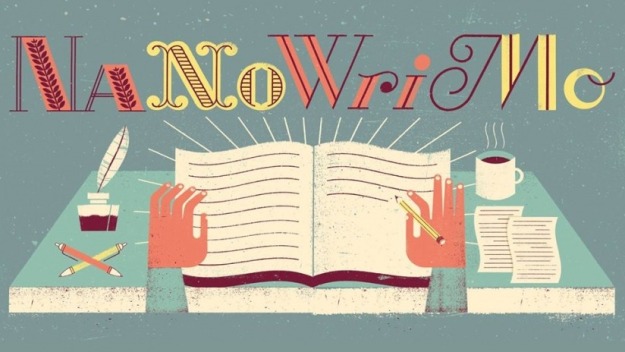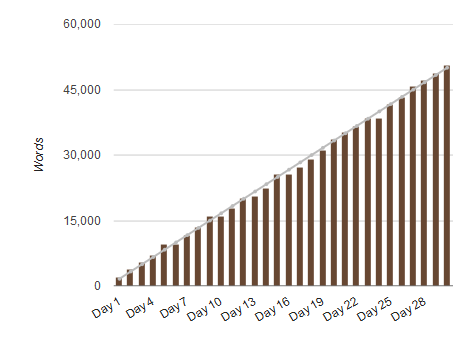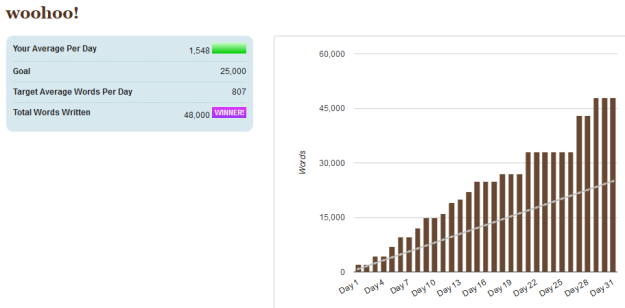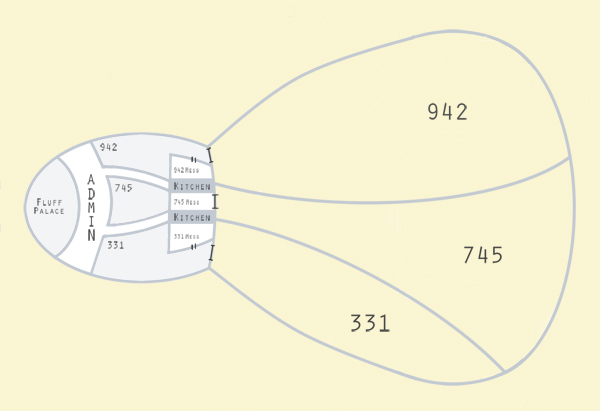Last night (technically, this morning) I finished writing my book.
This is a statement that’s far less dramatic than it may at first appear – since I wrote the book hoping it would be traditionally published, me arriving at a draft that I consider “final” doesn’t really mean much.
Now comes the stage of sending the book to agents, waiting, hoping and praying one of them might want to represent my work, then, if I’m very lucky, the book would be submitted to publishers, then, if I’m even luckier, I would get to revise it until the editor and I agreed it was ready for publication. And then, some indeterminate time later, it might be available for people to read.
In a way, being “done” writing this book is the beginning of trying to get it published, which again if I’m very lucky will probably include revisions.
Still, I do want to note this day.
A (not so brief) history of 5 drafts
I began writing this book 3 years and a few months ago, on November 1st. I remember that, because for a few weeks I’d been doing all the necessary prep to begin writing the first draft (I’ve been planning and developing this book for over a decade), and kept freaking out about actually putting words down and beginning the process. It felt to me like once I actually put words down, I either finish the draft and continue working on the book until it’s done, or I give up somewhere along the way, for whatever reason, and the failure hangs over me forever. (A small intervention and lots of hugs from writer friends was required to get me to overcome that freakout.)
And then I realized that it was November 1st, and Nanowrimo had started, and was like, well! I always wanted to do Nano, sounds like a perfect opportunity. It’ll give ma schedule and motivation to get through the draft quickly, and prevent me from thinking about things too much.
So I did that. I wrote 50,000 words during the actual month of November. In the post I wrote about the lessons I learned from Nanowrimo, I mention that I basically did nothing but work, write and sleep (barely). But I got it done!
I then needed a break to do other things, and then I came back to the draft and wrote 30,000 words more, for a total of 80k. I then went over the whole thing to make it readable and understandable to someone other than me. I knew I’d need that pass when I started Nano, so for me that whole process was part of getting to a proper first draft, the kind I could actually send out for beta.
I knew, even before I started Nano, that the book would likely have 5 drafts all in all. Or rather, I hoped it would be 5, because I couldn’t see myself finishing it with fewer, but knew that it could certainly balloon up to however many drafts would be necessary to fix its various problems.
And so, the Nano draft was the first one. It took me about 5 months, if memory serves, after those feverish 31 days, to get the text to where it worked and made sense to an outsider.
I remember because I went to Worldcon that year (the last Worldcon before the pandemic), I was leaving in July and I knew I had to finish the draft and send it to betas now, or risk taking many more months to do so. I was beginning to discover that writing a draft was always a very intense time for me, and if I let up even a little bit, if I took a real break from it, it took a while to get back into that headspace.
I was still missing the book’s ending by the time I had to leave for Ireland, so for the last 8-10k I pasted in what I’d written for Nano.
Beta comments came back, for the most part, before I even landed in Dublin. Keep in mind the book was about 80,000 words at that point! Still unbelievable to me, as a slow reader. I thought a few weeks of travel would mean not stressing about when my beta readers would be done, but they ended up being weeks when I was vaguely frustrated I couldn’t do anything about the feedback I already had, lol.
As I’d predicted, it took a while for me to get back into the book when I came back from travel. I didn’t really start until November, again for Nano. This time though I was editing a draft, not writing a new one. I still used the Nano website, which turned out to be extremely useful and helpful.
That second draft ended up being the longest of the novel so far: 137k words. Basically, feedback from the first draft came down to there being a lot of the book missing, and so in the second draft I just put everything in. Every piece that had been in my head but not on the page made it into this one.
I used a lot of the same Nanowrimo tools to write it as before, but the draft just… wouldn’t end. Because I write so intensely during a draft, it was also hard to maintain that level of total commitment to writing, at the cost of everything else including my health, for long.
By February 2020 I felt like the draft would take forever to complete, and derail the tentative schedule I’d set for myself entirely. “Thankfully” that was when the pandemic began. Due to fortunate circumstances, my job at the time essentially put me on paid leave for about 5 weeks.
These were the days of the very first lockdowns, when everything was terrifying, and very little was known about the virus. For 5 weeks I was basically shut in at home with one other person, the two of us barely going outside or meeting anyone.
The writing helped me deal with the anxiety and uncertainty of that time. Without social obligations or my day job, I could spend literally all day writing, and not think about anything else, which is what I did. I wrote 62,000 words in the first 3 weeks of that period, completing the second draft. I wrote more fully about that process and all the techniques I used to motivate myself and stay on track, with pictures!
By April the new draft went out to betas.
Again, an intense period of writing meant a long, long break. Once I was done with the draft, it was harder to get my mind off the world falling apart, globally but also personally. A lot changed for me in the coming months – I lost my job, had to change my living situation, and of course, there was still a pandemic raging outside.
It took a long time to get beta feedback, and to decide what to do with it. I’d basically written an extremely bare bones first draft, and an extremely bloated second one, and now I needed to decide what the third would look like.
Again, I found myself working on it in the fall, though this time there was no point in doing Nano. I knew the draft would be mostly editing, some rewriting. I needed to distill the story to the parts that really mattered, create a cohesive and complete version of it that I would then make better and better. Draft 3 needed to be the last one with major structural changes.
I spent more time planning and strategizing about the 3rd draft than any other. The writing was secondary to the outlining, the preliminary work that needed to be done before I started changing the words.
I ended up planning for about 3 months, and then writing through the winter and early spring. The draft ended up 112k, and I knew it was a far more cohesive, complete version of the narrative. I’d gotten rid of one of the main characters, I’d thrown out a bunch of sections, I’d changed the order of things here and there.
Draft 3 went to betas almost a year after draft 2 was complete. In March 2021.
This time I kept the circle small again. I wanted a mix of people who had fresh eyes on the work, but also people who’d seen it grow and change and could tell me whether I was going in the right direction.
This time, perhaps because the writing period had been longer and not so overwhelmingly intense, I could also get back to writing the next draft much quicker.
Again, I spent more time planning out changes based on the feedback, strategizing and working on the outline. I felt like at this point, this would be the bulk of the work. There was really nothing I could improve anymore by just diving into the story, 90% of the work had to be in looking at structural things, elements, characters, etc., and making big-picture changes.
Basically, the cycle of beta feedback went like this:
1st draft:
Good potential, bits and pieces of this are good, but overall it doesn’t work
2nd draft:
OK, the second half works, but the first half totally doesn’t
3rd draft:
OK, the first quarter of this doesn’t work, but once you get past that it gets good
So a lot of my focus for draft 4 was to improve that first quarter. I wrote different versions of the opening scenes, outlined the first quarter specifically, really tried to break it down and reassemble it so it actually worked better.
I was almost done with draft 4 by August 2021, when my life changed drastically again, limiting my writing time to almost zero for a good few months. I was so close though! Just another week or two of work on the draft and I’d have been done.
Ultimately, I did finish the 4th draft, though I didn’t send it out for a full round of beta. I showed parts of it, got feedback on specific changes, specific scenes or moments.
This draft was basically improving the first quarter of the book and fine tuning everything else. It ended up being 115k. Not ideal, but ultimately doable for an epic fantasy.
This brings us almost to current times.
I could have sent the book out to agents after draft 4, I knew that many writers would have sent it even earlier. But for me, it needed one more pass: exclusively for the prose.
I’m sure part of this is influenced by me not actually being a native English speaker, and the other part by the fact that I was a poet before I was a writer (though my poetry was published later than my prose), but I’d spent 3 years working on this book giving myself permission not to care about phrasing or cleverness or the elegance of the prose, because I knew every word would end up getting rewritten.
Now, when it was finally Done, I had to take time to actually go over the language and make sure none of it was too embarrassing. I thought I’d take 4-6 weeks to go over the manuscript at my leisure, tightening phrasing, getting rid of redundancies, catching tiny continuity errors.
I deliberately set a rule for myself that this final pass would not be for anything but prose changes. No matter how much my brain might try to convince me that actually, the entire third act needs to be restructured, I had given this book so much time and attention, and I was happy with it, and it was time to move on. The prose pass was for style exclusively, not substance.
And so, here we are. Due to constraints that I can’t talk about yet (maybe one day! if the book ever sells) I actually finished the prose pass my earlier.

I began on January 7th and finished it 20 days later. I ended up cutting about 1,000 words of prose, ending up with a final draft of 114,000.
The book is done. It’s as good as I can make it with my meager talents, and from here whether it ever sees the light of day is ultimately not within my control.

I can’t believe it’s actually over. This project will no longer be the main thing I’m doing. It’s moving from the WIP folder to the “complete” folder, if only in my head, which is just… wasn’t sure this day would come, you know?
Thank you, to anyone reading this, for making it this far. If we’ve spoken at any time during the last 3 years, thank you for being part of the journey of writing this book. I am accepting all good wishes at this time that someone will want to publish it, haha.
But regardless of its status within the commercial realm of publishing, I did it. I finished it. I started and I kept at it and now it’s done. It’s not the most stellar, but it’s not too shabby either, in my own estimation, which I’m enormously proud of.
What will I do next?
Something tells me working on my next novel right now would be a bad idea, I really do need a break. So, fanfiction, my podcast, articles and short stories I owe to editors, all of those are now possibilities!
Stay tuned 🙂

 Hello again, friends!
Hello again, friends! At the start of 2018 I had a few writing goals: spend the first six months of the year writing short stories (hopefully about one a month) and the last six months working on my novel draft. I hoped I’d have half of my first draft done by 2019, but I knew these were very optimistic plans.
At the start of 2018 I had a few writing goals: spend the first six months of the year writing short stories (hopefully about one a month) and the last six months working on my novel draft. I hoped I’d have half of my first draft done by 2019, but I knew these were very optimistic plans.




 I have a new poem out in Strange Horizons! It’s called “Survival in Six Easy Steps” and it’s very different from most of the poems I’ve written before. For one thing: it doesn’t have a love story.
I have a new poem out in Strange Horizons! It’s called “Survival in Six Easy Steps” and it’s very different from most of the poems I’ve written before. For one thing: it doesn’t have a love story. I’m very excited to announce that I have a new poem in the latest issue of Arsenika!
I’m very excited to announce that I have a new poem in the latest issue of Arsenika!
